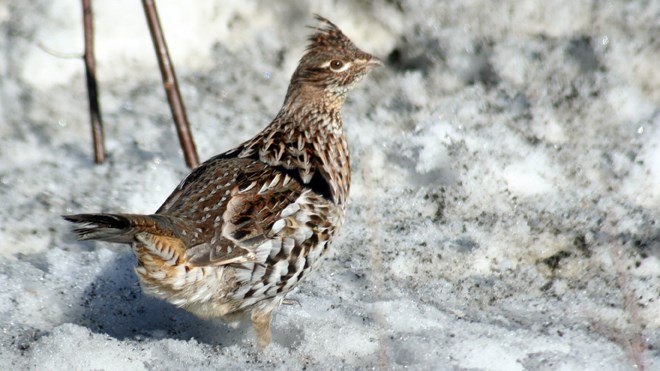I was in the Coniston LCBO the other day and struck a conversation with a resident of that fine area.
She told me of a legend that goes something like this: There is a tale that if no one strikes a mosquito, we would never be bothered by the six-legged critters. They have a great many relatives and so the story goes that if no one provokes them by causing bodily harm, the relatives would have no excuses for a family blood-sucking vendetta.
Perhaps you, the reader, should consider this the next time a mosquito lands on your arm. After hearing this tale in good humour, I promptly grabbed my product and walked out into the bright sunny, warm day.
The snow that comes and goes is not staying long and the sunlight hours, part of our photo period, is getting longer. The early migrants are arriving and perhaps the most obvious are the return of those boisterous Canada geese.
Although there are still vast stretches of ice on the lakes such as Ramsey, Robinson, Whitewater and Kelly, there are fringe areas, particularly where streams flow in or out of the waterways that are widening.
The geese are capable of making landings on these patches of water, but in a pinch can certainly negotiate a landing on ice, slide though they might. Nesting comes early for geese.
Those that live in the country or near parkland may notice a change in ruffed grouse behaviour.
A recent drive down North Road in Markstay revealed no less than six birds. Some were looking for tasty spring fare along the ditches where the grass and some small plants were making an appearance.
At one location, a male in full display had an audience of three females close by. The grouse puffs out its body feathers, fans its tail and erects it in an almost 90-degree fashion from the body, extends the black neck ruff, from which it gets its name, and struts its stuff.
Male grouse can get so engrossed in this activity that, in this case, I was able to pull over with the car and turn off the engine to watch the display. In Lively during the same week, another male came into the ground feeder in full display, while picking seeds from the ground. Ruffed grouse nest early in the season and rear large broods.
Other birds that have made it back to our region are ring-billed and herring gulls. There are several colony islands in the region and these gulls will often claim their small square foot of nesting ground even when the snow is still on the patch. Loud vocalizations are made to claim ownership as competition is intense.
Now back to Coniston. It won’t be long before the weather warms up consistently and those winged invertebrates start to make an appearance. Black fly and mosquito become a large part of the diet of migrating and resident warblers as well as a number of other migrants such as swallows and flycatchers.
Once again it is a time to “Look Up.”
Chris Blomme is an executive member of the Sudbury Ornithological Society and works with animals at Laurentian University. Have a question for Chris? Send it to [email protected].
Join Sudbury.com+
- Messages
- Post a Listing
- Your Listings
- Your Profile
- Your Subscriptions
- Your Likes
- Your Business
- Support Local News
- Payment History
Sudbury.com+ members
Already a +member?
Not a +member?
Sign up for a Sudbury.com+ account for instant access to upcoming contests, local offers, auctions and so much more.
